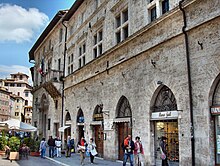Capitano del Popolo
The Capitano del Popolo was a local government political figure who was on duty in medieval Italy and was essentially intended to balance the power and authority of noble families . As with the Podestà , the term of office was limited to one year, later often to six months in order to prevent abuse of power as much as possible. As with the Podestà, the position was filled by people from outside.
history
The "Popolo" was the rising middle class of the people initially excluded from political activity, which was the exclusive prerogative of the milites , the feudal noble knights. With the rise of the cities, layers of "new people" ( gens nova ) were created (to quote the same phrase used by Dante Alighieri ), emerging from the landed gentry who had moved to the city and made rich from the demand caused by population growth made up of groceries, bankers, merchants, connoisseurs of the liberal arts (lawyers and doctors), craftsmen and, in the coastal cities, shipowners who had enriched themselves through trade with the crusader states. It was founded to defend the interests of the population against the rulers and thus to oppose the mayor ( Podestà ), who was considered a representative of this class.
From the beginning of the 13th century, the populares gradually managed to participate in the political life of many Italian cities by setting up assemblies of the people who elected a Capitano del Popolo to accompany the Podestà. The Capitano del Popolo exercised his control over the Podestà, while the two councils remained autonomous, in which the representatives of the guilds and the Gonfalonieri , commanders of the parish troops, took part. In practice, the person of the Capitano del Popolo formed the political counterweight to the strength of the noble families and represented the bourgeoisie of the time.
practice
In Bologna there was a Comune di Popolo and a Capitano del Popolo since 1228 . The Florentines tried to free themselves from the rule of Frederick II of Swabia in 1250 by founding a government of the elderly, whose Capitano del Popolo was one of the highest magistrates and, together with the council of elders, took part in the city's political life . In the Compagna Communis , from which the Republic of Genoa was to emerge, the role of the Capitano del Popolo was just as important and produced figures of historical importance, such as that of Guglielmo Embriaco . Mantua had its first Capitano del Popolo with Luigi Gonzaga , who began the Gonzaga rule with the killing of Rinaldo dei Bonacolsi , which lasted until 1708 .
chronology
- Bologna (1228)
- Milan (1240) with Pagano della Torre
- Florence (1250)
- Siena (1252)
- Cremona (1271)
- Mantua (1328) with Ludovico I Gonzaga
Individual evidence
- ↑ Capitano del popolo siena ( Italian )
literature
- Carlo Ghisalbert: Capitano del popolo . In: Lexicon of the Middle Ages (LexMA). Volume 2, Artemis & Winkler, Munich / Zurich 1983, ISBN 3-7608-8902-6 , Sp. 1475–1477 with extensive literature.
- Hagen Keller : Capitaneus . In: Lexicon of the Middle Ages (LexMA). Volume 2, Artemis & Winkler, Munich / Zurich 1983, ISBN 3-7608-8902-6 , Sp. 1475 on the development of terms.
- Giuliano Milani: I comuni italiani . Laterza 2005 (Italian).
Web links
- Publications on the capitano del popolo in the Opac of the Regesta Imperii
- Capitano del popolo ( Italian ) Biblioteca Nazionale Centrale di Firenze. Retrieved January 17, 2019.
